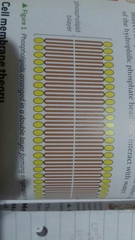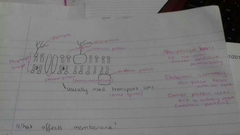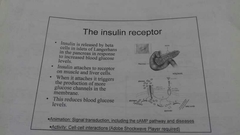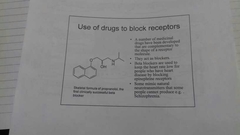![]()
![]()
![]()
Use LEFT and RIGHT arrow keys to navigate between flashcards;
Use UP and DOWN arrow keys to flip the card;
H to show hint;
A reads text to speech;
24 Cards in this Set
- Front
- Back
|
What are the roles of plasma membranes? |
- Seperating cell contents from the outside enviroment - seperating cell content from cytoplasm - cell recognisition and signalling ( important for immune system and hormones) -Holding components of metabolic pathways in place - Regulating the transport of materials in or out of cells |
|
|
Membrane structure: Phospholipids |

Made out of phosphate, glycerol and fatty acid. - The charge makes head hydrophillic and fatty acid chain are hydrophobic. When they are completely surrounded by water it forms a bilayer- tails point towards each other, away from water - tails can still move but heads can't move that easily |
|
|
What can not pass through the middle of plasma membrane? |
Charged ions, large molcules |
|
|
Cell membrane theory |
• 1924- possibly a bilayer ( Gortor and Grendel) • 1935- orginal model of membrane proposed (Danielli and Davson) •1940- First electron microscope images of cell membrane produced •1954- publishes the revised version of model (Danielli and Davson) •1959- J.D.Robertson proposes his model. Struture of a protein identified for the first time •1972- Singer and Nicholson publish fluid mosaic model. •1999- Grunther Blobel recieve Nobel Prize for pioneering work on the mechanisms by which proteins intergrate with membrane |
|
|
What is the structure of plasma membrane? |

|
|
|
What is the role of Phospholipids? |
Form basic structure Selectively permeable |
|
|
What is the role of Cholestrol? |
- Regulates fluidity of the cell - helps with permeable stability by fitting between fatty tails - Makes membrane more of a barrier to water and ions |
|
|
What is the role of Channel Protein? |
Allows the movement of some substances across the membrane e.g. ions |
|
|
What is the role of Carrier Protein? |
Uses ATP to actively move substances across the membrane |
|
|
What is the role of Glycoprotein? |
Cell recognition, hormone receptors and can bind cells together |
|
|
What is the role of Glycolipids? |
Cell recognition and hormone receptors |
|
|
What are Intrinsic proteins? |
Transmembrane proteins embedded throgh both layers of bilayer. They have: Amino acids with hydrophobic R-groups. They interact with hydrophobic tails and keep them in place |
|
|
What are Extrinsic proteins? |
Perioheral proteins are present in one side of bilayer. They have: hydrophillic R-groups on their outer surface. They interact with phospholipid heads. |
|
|
How does temperature affect the membrane? |
•More temp= more kinetic energy= phospholipids and other componenets cause the membrane to be leaky as it disruptive membrane • More temp= more kinetic energy= proteins denature |
|
|
How do organisms in extreme enviroments cope with temp? |
organism in extreme enviroments need different amount of components such as cholestrol so that they can be successful.E.g. Cod has cholestrol to withstand pressure of ocean.Organism near the oceanic plate (extreme thermophile) |
|
|
How does alcohol affect membranes? |
Phospholids dissolve in alcohols, disrupting cells. It becomes more fluid and more permeable. Cells need to be intact cell membrane e.g. transmission of nerve impulses by neurones |
|
|
What are hormones? |
They are chemical messengers that are peoduced by a cell to act on a diiferent target cell. They are sent out via the circulatory system |
|
|
What happens to hormone at the plasma membrane? |
Signal molecukes fit into receptor molecules in certain cell surface membranrs. This is because their shapes are complementary. |
|
|
Example: Insulin receptor |

|
|
|
Uses of drugs to block receptors |

|
|
|
Hijacking receptors |
• Some viruses can use the normal cell membrane and get into cells Example:HIV can bind to CD4 receptors on helper T lymphoctyes, enter and hide and kill one of the cells trying to build up an immune respose against it |
|
|
What is diffusion? |
The net movement of molecules from a region of high concentration of that molecule to a region of low concentration of that molecule, down a concentration gradient. PASSIVE process. |
|
|
What do cell needs to transport? |
•Supply nutrient molecules •Removal of water |
|
|
What affects rate of diffusion? |
• Temperature- more kenetic energy, the faster rate • Concentration gradient • Stirring • Surface Area • Distance |

